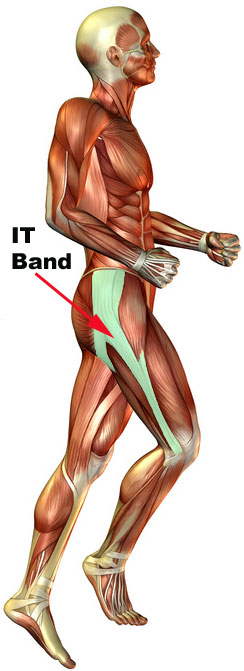Do you have chronic knee or hip pain? Do you feel a snapping or popping at the knee or hip? You may have Iliotibial band syndrome, ITBS, commonly known a runner’s knee.
What is the IT band?
The IT band is a thick band of connective tissue that attaches at the top of the hip or iliac crest and descends along the outside of the thigh down to the outside of the knee (see photo). Its primary function is to assist with stabilizing the hip and knee particularly during single leg activities like walking, running and stepping.
What types of symptoms are associated with the injury?
- A sharp or burning pain around the affected knee.
- Pain radiating up the side of the hip or thigh.
- Swelling at the location of discomfort.
- Snapping and popping sensation when the knee is bent.
How is it damaged?
The IT band can develop scar tissue due to trauma associated with running and cycling. Eventually, it starts to adhere itself to the front of the thigh, hip flexors and hamstring muscle groups. The IT band is supposed to glide over these muscles but instead starts to pull and tug resulting in rips and tears.
Initial Self-Treatment
We usually recommend the RICE protocol (Rest, Ice, Compression, and Elevation) when you first injure your Iliotibial Band. This will help to reduce the inflammation caused by the injury.
- Rest – Avoid putting additional stress on the knee. If necessary, use crutches to support your weight, along with a neoprene brace to keep the knee locked in extension.
- Ice – Apply ice to the knee for 20-30 minutes, every 2-3 hours, until the swelling is reduced.
- Compression – Apply an elastic bandage to your knee in conjunction with the ice, to reduce swelling.
- Elevation – Elevate your leg to help reduce inflammation. Use a rolled up blanket or pillow under your knee.
How does Soft Tissue Therapy help?
When treating an IT band injury, we commonly combine two methods of Soft Tissue Therapy to get the best result in the shortest amount of time. We use Graston instruments to penetrate deep into the band. This increases the amount of blood supply to the thick-scarred area helping it to regain elasticity. We then combine with A.R.T, Active Release Technique, hands-on maneuvers to release adhesions between the muscles and tendons, allowing them to “glide” over the muscles instead of pull and tug.
Lastly, we show our patients strength exercises, stretches, and methods of self-massage that can assist in the healing process and reduce further pain and injury to the area.

